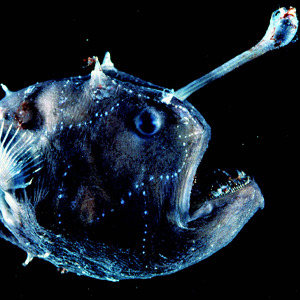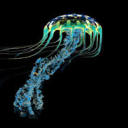Football Fish


Football Fish
Himantolophus paucifilosus
The Football fish is a deep sea angular fish located between 1000 to 4000 meters in the ocean. The glowing dots on its body are sensory organs called neuromast that help the fish detect changes in the water.
Photo credit: https://alchetron.com/Footballfish
https://www.amazon.com/Creatures-Deep-Search-Monsters-World/dp/1770852816
More Posts from Bioluminescentoceangoddess and Others


Sea elephant
Carinaria japonica
The Sea Elephant is a translucent sea snail that has a large muscular body and a tiny triangular shell. Its foot is used for crawling on the ground, and it can be transformed into a fin that is used for swimming. It is called the “sea elephant” because it has a small trunk in its mouth that is used to swallow prey. Furthermore, the Sea Elephant eats arrow worms and jellies.
Photo credit
https://bodegahead.blogspot.com/2014/12/carinaria-part-2.html
http://tolweb.org/Carinaria_japonica/28750


Atolla Jelly
Atolla wyvillei
The Atolla Jelly is a fiery, red jellyfish that has an extraordinary display of bioluminescence. When the jelly is attacked, it uses bioluminescence to produce thousands of vibrant, blue flashes; the blue flashes act as an alarm, which draws in bigger predators and warns prey. The jelly can be found at depths between 600 m to 1500m, and it also has a long hypertrophied tentacle that aids in reproduction.
Photo credit: https://en.wikipedia.org/wiki/Atolla_jellyfish
https://en.wikipedia.org/wiki/Atolla_jellyfish

Black Medusa
Vampyrocrossota childressi
The Black Medusa is an inky, black hydrozoan that absorbs all light that hits its tiny body. It has a translucent gelatin and a black umbrella; it is also only 1.5 cm in size. Moreover, it is found at depths between 600m to 1500m, and it spends its entire life floating in the deep ocean.
Photo credit: https://www.pinterest.com/pin/488148047080475827/


Googly-eyed glass squid
Teuthowenia pellucida
The Googly eyed squid is a rare oddity that is found in the southern hemisphere. It has a large, spherical head that is filled with water and teeny, tiny tentacles that help propel it through the water. If it comes across a predator, it deflates its head and draws its tentacles into its cavity. On the other hand, it may also fill the cavity with water to increase its size, and intimidate the predator. If all fails, it will ink and try to escape through the darkness. Furthermore, baby squids can be found at the surface (0-600m); then slowly migrate downwards as they mature into adults (1600-2500m).
Photo credit: http://animaladay.blogspot.com/2011/07/googly-eyed-glass-squid.html
https://faunafabula.tumblr.com/post/5999675353/googly-eyed-glass-squid-teuthowenia-pellucida


Physonect Siphonophore
Nanomia cara
The Physonect siphonophore has tiny, bubble shaped sacs that are filled with gas. The sacs are called pneumatophores and help this creature move through the deep ocean. It also has venomous tentacles that stun prey and over eighty stomachs. There are numerous amounts of these strange creatures along the east coast, and they have cause some fisheries to collapse. Furthermore, they can be found at depth between 400m to 1000m.
Photo credit: http://www.seawater.no/fauna/cnidaria/cara.html
https://www.mindenpictures.com/stock-photo-siphonophore-hydrozoan-cnidarian-nanomia-cara-atlantic-nectophores-naturephotography-image90194961.html





Wake up babe new fish dropped

Brittle Stars
Asteroschema Ajax
Brittle stars are in the phylum Enchinodermata and are closely related to sea stars. They have long stringy arms and small podia on the bottoms of their body. They also have a hydrostatic skeleton and have a complex water vascular system. When attacked, they will abandon their arm to confuse predators and make a hasty escape. The photo above is a deep sea brittle star that lives in coral reefs.
Photo credit: https://species.wikimedia.org/wiki/Asteroschema_ajax

Threadfin Snailfish
Careproctus longifilis
The Threadfin Snailfish resembles a prehistoric tadpole that is ghostly white. The holes in its face are large sensory pores that help them detect changes in the ocean. It is often found at depths between 1900 to 2997 meters.
Photo credit: https://www.timeout.com/singapore/museums/creatures-of-the-deep


Silky Medusa
Colobonema sericeum
The Silky Medusa is a gentle and reserved jellyfish; it has white-tipped tentacles that have the ability to detach from its body and bioluminescence when attacked by predators. It can be found drifting between 500 m to 1500 m. Furthermore, it consumes small crustaceans.
Photo credit: https://twitter.com/mbari_news/status/949736123760340994
https://www.montereybayaquarium.org/animals/animals-a-to-z/midwater-jelly


Cockatoo Squid
Galiteuthis phyllura
The Cockatoo squid is a highly-specialized oddity of the deep ocean and found at depths between 300 to 1400 m. It is completely transparent, except for its eyes. It also has bioluminescent photophores that are directed downward: this makes it difficult for deep sea predators to see the Cockatoo Squid. It was named after the Cockatoo because it holds its tentacles above its head, resembling the bird. The Cockatoo squid can also get fairly large with adults reaching lengths of 2.7 meters (over 6 ft.)
Photocredit: https://www.americanscientist.org/article/at-home-in-the-dark
https://www.pinterest.com/pin/28710516347382519/
-
 absolutesciencefiction reblogged this · 1 year ago
absolutesciencefiction reblogged this · 1 year ago -
 mycellpics liked this · 1 year ago
mycellpics liked this · 1 year ago -
 androidsghost liked this · 1 year ago
androidsghost liked this · 1 year ago -
 nautilidaes reblogged this · 1 year ago
nautilidaes reblogged this · 1 year ago -
 devotionaldesire reblogged this · 1 year ago
devotionaldesire reblogged this · 1 year ago -
 blackwaterhikikomori reblogged this · 1 year ago
blackwaterhikikomori reblogged this · 1 year ago -
 dirtj0b liked this · 1 year ago
dirtj0b liked this · 1 year ago -
 kissing-the-abyss reblogged this · 1 year ago
kissing-the-abyss reblogged this · 1 year ago -
 stardustandmoonflowers liked this · 1 year ago
stardustandmoonflowers liked this · 1 year ago -
 thecloudpup-blog liked this · 2 years ago
thecloudpup-blog liked this · 2 years ago -
 amethysthorizon reblogged this · 3 years ago
amethysthorizon reblogged this · 3 years ago -
 rhincodon-cynocephalus liked this · 3 years ago
rhincodon-cynocephalus liked this · 3 years ago -
 redwolf1999 liked this · 3 years ago
redwolf1999 liked this · 3 years ago -
 aganatis liked this · 3 years ago
aganatis liked this · 3 years ago -
 battlemage94 liked this · 3 years ago
battlemage94 liked this · 3 years ago -
 chopped-peace-collection liked this · 3 years ago
chopped-peace-collection liked this · 3 years ago -
 sothatidostuff reblogged this · 3 years ago
sothatidostuff reblogged this · 3 years ago -
 algaejay liked this · 3 years ago
algaejay liked this · 3 years ago -
 blueorandas reblogged this · 3 years ago
blueorandas reblogged this · 3 years ago -
 blueorandas liked this · 3 years ago
blueorandas liked this · 3 years ago -
 ryzomeriseup liked this · 3 years ago
ryzomeriseup liked this · 3 years ago -
 astrotracksuitbattalion liked this · 3 years ago
astrotracksuitbattalion liked this · 3 years ago -
 rocksgocha-ching liked this · 3 years ago
rocksgocha-ching liked this · 3 years ago -
 acolorcollective liked this · 3 years ago
acolorcollective liked this · 3 years ago -
 gothfrog-44 liked this · 3 years ago
gothfrog-44 liked this · 3 years ago -
 despair-with-walnuts liked this · 3 years ago
despair-with-walnuts liked this · 3 years ago -
 slime-gargoyyyle liked this · 3 years ago
slime-gargoyyyle liked this · 3 years ago -
 trucko1000 liked this · 3 years ago
trucko1000 liked this · 3 years ago -
 liina-puff liked this · 3 years ago
liina-puff liked this · 3 years ago -
 in-soft-grass reblogged this · 3 years ago
in-soft-grass reblogged this · 3 years ago -
 steal-this-album liked this · 3 years ago
steal-this-album liked this · 3 years ago -
 in-soft-grass liked this · 3 years ago
in-soft-grass liked this · 3 years ago -
 420champ liked this · 3 years ago
420champ liked this · 3 years ago -
 notyourgiuseppe liked this · 3 years ago
notyourgiuseppe liked this · 3 years ago -
 thornandbriar liked this · 3 years ago
thornandbriar liked this · 3 years ago -
 docegrotesco reblogged this · 3 years ago
docegrotesco reblogged this · 3 years ago -
 docegrotesco liked this · 3 years ago
docegrotesco liked this · 3 years ago -
 ibelievergladiator liked this · 3 years ago
ibelievergladiator liked this · 3 years ago -
 chloris-ara reblogged this · 3 years ago
chloris-ara reblogged this · 3 years ago -
 fulltimesinker liked this · 3 years ago
fulltimesinker liked this · 3 years ago -
 hobokenbill liked this · 3 years ago
hobokenbill liked this · 3 years ago -
 chrysalyos reblogged this · 3 years ago
chrysalyos reblogged this · 3 years ago -
 chrysalyos liked this · 3 years ago
chrysalyos liked this · 3 years ago

Bioluminescence is a chemical reaction that produces light. Many deep sea animals use bioluminescence. This blog is dedicated to educating the public about the amazing creatures that thrive in the deep sea.
57 posts